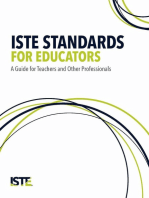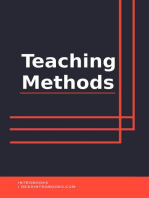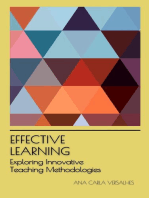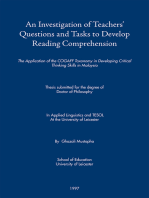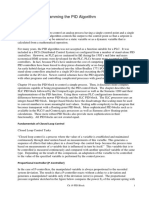Active and Situated Learning
Uploaded by
Mohamad Siri MusliminActive and Situated Learning
Uploaded by
Mohamad Siri MusliminInternational Journal of Information and Education Technology, Vol. 3, No.
3, June 2013
Pedagogycenteredon Learner in E, M and P-Learning
Continuum: Active and Situated Learning
Najima Daoudi and Rachida Ajoun
mobile technologies for applying these approaches and
success factors from the integration of these approaches to
enhance quality of d-learning.
AbstractLearning is one of the crucial fields of activity
that have benefited from exponential technological
development. D-learning has experienced three main
generations: E-learning, M-learning and P-learning.
Technology alone is not sufficient to create a higher quality of
learning. In this sense, we propose to analyze and study two
pedagogical approaches: active learning and situated learning.
Active learning proposes to make learner at the center of
learning and to consider its own knowledge, interpretations
and assumptions. The second approach is situated learning
which requires the implementation of learning in real contexts.
We observed that, despite the advantages of both approaches,
their implementation in classical learning is very difficult if not
impossible.
Thus, we propose to analyze the opportunities offered by the
continuum E, M and P-learning to put into practice its
approaches.
II. D-LEARNING
The learning field has undergone several changes
following the technologies and web services that have
emerged. The first generation E-learning, the second is Mlearning and actually P-learning. Prodigious technological
evolution produce E, M and P continuum.
Index TermsD-learning, active learning situated learning,
collaboration, engagement, real context.
I.
INTRODUCTION
To ensure efficient d-learning, designing relevant
contents and providing the necessary platforms and learning
devices, though necessary, do not suffice. In fact, learner
cant enter in learning situation and achieve the desired
goals without being sufficiently motivated and engaged in
the learning process. To do this, the integration of
pedagogical approaches is essential. These provide methods
and strategies that allow the learner to acquire knowledge
and skills. Among approaches that have proven their
usefulness: active learning and situated learning. These
approaches put the learner at the center of the learning
process. However, they are difficult to be applying in
classical learning.
What is the applicability of these approaches in the dlearning? What are the opportunities offered by new
technologies (mobile and pervasive) to apply these
approaches? How can they improve the quality of d-learning?
This paper attempts to answer these questions.
In the first section we present our definition of d-learning
that includes the E, M and P learning. In the second section,
we focus on two approaches to active learning and situated
learning to pinpoint the difficulty of their implementation in
classical learning. The third section will be devoted to the
presentation of the opportunities provided by pervasive and
We believe that it is time to return to the original concept
distance learning (D-learning), as shown in Fig. 1, to
combine all those concepts which usually are intertwined on
several aspects.
We define D-learning as a learning environment enabling
all actors to perform their tasks in technological
environment. Learning environment that ensures the quality
improvement of the learning process, regardless of any
constraints, offers services using the web and appropriate
pedagogical approaches to the context of each actor, as
shown in Fig. 2.
.
Fig. 2. Our D-learning vision.
In order to allow learners to achieve the learning
objectives of the activities offered in a processed-learning it
is essential to choose the most appropriate pedagogical
approaches to their contexts. Among the approaches that
Manuscript received February 21, 2013; revised April 30, 2013.
Najima Daoudi and Rachida Ajoun are with the University of Ecole des
Sciences de lInformation ESI, Morocco (e-mail: daoudinajima@yahoo.fr).
DOI: 10.7763/IJIET.2013.V3.297
Fig. 1. E, M and P learning continuum.
358
International Journal of Information and Education Technology, Vol. 3, No. 3, June 2013
have proven their relevance and contribution: active
learning and situated learning. We will discuss in the next
section the applicability of these approaches in the dlearning.
Certainly, such methods can enhance learning process by
transfer of new knowledge, improving critical thinking
skills, increasing preservation and motivations. Active
engagement and interaction are two important aspects in
promoting deep approaches to learning and are essential to
achieving quality learning outcomes [3].
In classical learning: class is not highly homogeneous,
learners rhythms are different from one learner to another,
and time is limited. Subsequently, is it possible for the tutor
to provide a learner-centered learning and to keep learner
pace? This is very difficult. Can technology solve these
problems in the d-learning?
III. SUCCESSFUL PEDAGOGICAL APPROACHES: ACTIVE
LEARNING AND SITUATED LEARNING
Learning is a key factor in the development of human
capital. Obviously, it is not limited to a simple transfer of
educational content, more than that, it should allow learners
to use knowledge to acquire skills [1]. Several studies have
been developed with the aim of highlighting methods to
improve the quality of learning. Learning pyramid, Shown
in Fig. 3 illustrates average student retention rates.
B. Situated Learning
With the evolution learning needs based on the
development of skills, the practical implementation of
theoretical knowledge has increased. Indeed, the acquisition
of knowledge depends not only interact with other learners,
but also the context in terms of educational practice in a real
context. Hence, the importance of using the real context for
practical learning activities.
To implement such learning, situated learning has
emerged since last decades. Situated learning is the study of
how human knowledge in the course of develops activity,
and especially how people create and interpret descriptions
(representations) of what they are doing [5].
This approach, defined as the combination of cognitive
and constructivism, is highly recommended to achieve skills
in a specific area.
In this model, the location where learning takes place
plays a major role in the process of knowledge construction.
The concept of 'situation' covers several aspects of
physical, social and cultural environment, including
communication with peers during learning.
According to the theory of contextual learning, learning
occurs only when learners acquire knowledge so that they
make sense in their context of reference (their own memory,
experience).
The situated learning assumes that the mind seeks
naturally meaning in context i.ein the environment where
the person is located.
Is the classroom, in the classical learning process, the
favorable context for situated and active learning? What
opportunities offered by technological context?
We think that the pervasive and mobile technologies
integrated into the learning field provide new opportunities
for the learner to improve their learning.
Fig. 3. Average rate of student retention rates [2].
To implement methods that give the best learning results,
it is imperative to use appropriate pedagogical approaches.
We present in the first the most appropriate approaches that
provide high quality of learning.
A. Active Learning
Active learning put learner and their learning needs at the
center of learning process in contrast to behaviorist
approach in which teacher transmits learning content to the
learner who is passive. The resulting passivity is not only
an obstacle to deep learning but it also makes it difficult for
lecturers to gauge the degree of understanding that is taking
place. [3]
In fact, it is certain that the learner needs to use its own
prerequisites and compare the content and knowledge
offered by his tutor with his own assumptions and
perceptions for better performance. In this sense, active
learning proposes to give physical time to learner in order to
put content and learning activities in connection with his
own thoughts and prerequisites. Thus, active learning is
defined as process whereby students engage in activities,
such as reading, writing, discussion, or problem solving that
promote analysis, synthesis, and evaluation of class content.
Cooperative learning, problem-based learning, and the use
of case methods and simulations are some approaches that
promote active learning. [4]
This definition emphasizes some learning strategies
which can be used in an active learning process in order to
make leaner more committed in the learning process:
working in the structured group, problem solving, case
studies, individual activities, informal small groups,
simulation.
IV. SUCCESS FACTORS FOR A HIGHER QUALITY LEARNING IN
THE D-LEARNING
D-learning is a dynamic and iterative process focused on
the learner who uses technology amply to be more engaged
and motivated. Thus, he becomes able to construct their
knowledge and skills and reach the learning objectives.
A. Technological Environment Favorable to the
Application of Active Learning and Situated Learning
The overall quality of learning is improved when learner
have ample opportunities to clarify, question, apply, and
consolidate new knowledge. D-learning provides
359
International Journal of Information and Education Technology, Vol. 3, No. 3, June 2013
opportunities for learners to engage new material, serving
as guides to help them understand and apply information.
The first generation of d-learning has exploited wired
technologies that gave birth to E-learning. The second one is
characterized by the use of mobile technologies and Web
2.0 services which allows the appearance of M-learning.
Finally, the third generation we are witnessing today is
characterized by the integration of pervasive technologies
which hatched the P-learning.
Since the first generation, the d-learning could overcome
the spatial-temporal constraints of the classroom. Indeed,
this learning environment allowed learners a first degree of
mobility (even if broken). It also provided synchronous and
asynchronous sessions that allow the learner to take time for
physical linking content of proposed activities with their
own knowledge and assumptions. In addition, the student
became able to follow his own pace and he is free to choose
their own educational route. The most important E-learning
advantages are presented in Fig. 4.
which people interact with embedded (and mostly invisible)
computers (processors) and in which networked devices are
aware of their surroundings and peers and are able to
provide services or use services from peers effectively. [6]
Fig. 5. Some M-learning advantages in favor to use active and situated
learning.
Pervasive learning means that learner can follow the
learning activities everywhere. Pervasive technologies
provide an environment totally connected and consistently
available. The goal of pervasive computing, which
combines current network technologies with wireless
computing, voice recognition, Internet capability and
artificial intelligence, is to create an environment where the
connectivity of devices is embedded in such a way that the
connectivity is unobtrusive and always available.[7].
Through these technologies, the learner can be mobile, more
than ever before, in rich and varied contexts: smart contexts.
Content, despite of the device on which it is stored, can be
used simultaneously. Learners knowledge is always
updated and available all times. Subsequently, Learner
becomes more engaged and motivated. He can interact with
his environment to exploit existing data and applications on
different smart objects surrounding learner. He becomes
active because he can benefit from the environment to build
its own interpretations and check assumptions against the
physical and social context.
Fig. 4. Some advantages of E-learning environment favor to use active and
situated learning.
Mobile technologies provide a wider degree of mobility.
Mobile devices provide flexibility and accessibility to
geographical areas inaccessible with a conventional
computer. Subsequently, in addition to the advantages of Elearning, M-learning allows learner to be more autonomous
in choosing his physical learning context. He can choose the
appropriate environment for training focused on practical
aspects.
M-learning seems to present a better opportunity to
engage the learner in his training by allowing learning in a
real context such as in the field of anthropology, archeology
and geology. So, the situated learning can be applicable
thanks to mobile technologies.
In parallel with mobile technology, the web 2.0 services
and its successors have provided spaces for exchange and
sharing through the creation of virtual communities for
collaboration 2.0 allows learners to be more productive by
effectively sharing ideas, questions, proposals and
assumptions. Thanks to these virtual communities learner is
engaged in the process of learning consequently active
learning can be applicable.
The most important M-learning advantages are presented
in Fig. 5.
The third generation of d-learning is characterized by the
use pervasive technologies defines as An environment in
Fig. 6. Some M-learning advantages in favor to use active and situated
learning.
He may also solve problems rather difficult thanks to
interactions between the smart objects in its environment
and sensitive and richness context.
So the real context can be fully exploited and
collaboration can be carried out all the time and everywhere.
360
International Journal of Information and Education Technology, Vol. 3, No. 3, June 2013
learning, allow learners to achieve the educational learning
goals. Technologies have offered the ability: to engage the
learner in the learning process, to encourage learner
creativity, to support collaborative work, autonomy and
communication. Also, it allows learners to get feedback and
compare their ideas and assumptions to learning activities.
In parallel, they provide a better environment to put into
practice learner knowledge. Currently, the alliance between
technology and pedagogy enabled the continuum E, M and
P learning to provide the most appropriate environment for
learning centered on learner and enhancing learning process.
Learner is no longer isolated whatever its location. He
belongs to virtual communities mostly available to
accompany, guide and always keep him motivated and
committed. Some advantages of P-learning are illustrated on
Fig. 6.
We can conclude that the technologies integrated to the
field of learning and coupled with appropriate pedagogical
approaches, provide a dynamic environment for the
acquisition of knowledge, know-how and skills:
collaborative, situated and active learning are therefore
available.
B. Accompanying Measures to Better Engage the Learner
in D-learning Process
Pedagogical approaches ally to technologies provide a
good environment to learner but its not sufficient. He needs
to be more engaged in learning process in order to achieve
all of leaning pedagogical goals.
In order to make learner fully committed and motivated,
several accompanying measures are required:
The clarity of learning objectives.
Taking into consideration learner profile.
Allowing more autonomy in the sense that learner can
choose his own pedagogical route and its own pace.
Encourage learner creativity.
Put both theoretical learning with a practice in real
contexts.
Reinforcing learning process by a tutoring adapted to
learner technological and social context.
Allowing interactions and exchanges between learners
in virtual communities.
Taking into account informal content produced and
sharing by learners.
Creating collaborative structured workgroup.
Using constructive assessment methods.
Etc.
REFERENCES
[1]
[2]
[3]
[4]
[5]
[6]
[7]
N. Daoudi and R. Ajhoun, Pedagogical issues in M-learning:
Collaborative learning, presented at Conference ICL 2008,
September 24 -26, 2008, Villach, Austria.
B. Maine, National training laboratories (ntl) for applied behavioral
science, 300 N. Lee Street, Suite 300, Alexander, VA 22314, USA.
Excellence in Active and Interactive Learning. [Online]. Available:
http://www.qub.ac.uk/sites/CentreforExcellenceinActiveandInteractiv
eLearning/BiosciencesProject/ActiveandInteractiveLearning/
Center for Research on Learning and teaching. University of
Michigan
(U-M).
[Online].
Available:
http://www.crlt.umich.edu/tstrategies/tsal
W. J. Clancey, A tutorial on situated learning, in Proc. the
International Conference on Computers and Education (Taiwan) Self,
J. Charlottesville, (Ed.), VA: AACE, 1995, pp. 49-70.
M. V. Hooft and K. Swan, Ubiquitous computing in education:
Invisible technology, visible impact, Mahwah, NJ: Erlbaum
Associates, 2007.
R. Sharma, R. K. Sharma, and M. Kumar, Manet: the essential
technology for pervasive computing, IJRIM, vol. 2, no. 2, February
2012.
N. Daoudi was born in 1976 in Morocco. She
obtained her PhD at ENSIAS. Rabat, Morocco. The
thesis entitled MADAR Learning: interoperable
environment between E-learning and M-learning in
2009. She received Diploma of Higher Studies EMI,
Rabat, Morocco in 2004, and Engineer Degree at
INSEA, Rabat, Morocco in 1999. She worked as a
professor assistant in ESI since December 2000.
She is learning an interoperable environment for
E&M learning, and published IEEE Engineering Education 2010, The
Future of Global Learning in Engineering Education pp.14-16, April 2010
in Madrid/Spain.
Tutoring 2.0: how to improve tutoring system by using web
mining?INTED: the international technology, education and development
conference, Valencia, Spain, March 2013.
And also publish paper: Role of Model of excellence to improve dlearning project. International scientific conference relearning software for
education, Bucharest, April 25th - 26th, 2013.
V. CONCLUSION
Pedagogy is an area that has seen an extraordinary
development for a long time but unfortunately without
finding a suitable context for their application. The
integration of technologies in learning has overcome several
constraints. D-learning, when allied to active and situated
.
361
You might also like
- ISTE Standards for Educators: A Guide for Teachers and Other ProfessionalsFrom EverandISTE Standards for Educators: A Guide for Teachers and Other Professionals5/5 (1)
- Using Cutting-Edge Technology: Tools to Consider for Enhancing Learning In Grades Six through TwelveFrom EverandUsing Cutting-Edge Technology: Tools to Consider for Enhancing Learning In Grades Six through TwelveNo ratings yet
- Teaching Mathematics in the Middle School Classroom: Strategies That WorkFrom EverandTeaching Mathematics in the Middle School Classroom: Strategies That WorkNo ratings yet
- Classroom-Ready Resources for Student-Centered Learning: Basic Teaching Strategies for Fostering Student Ownership, Agency, and Engagement in K–6 ClassroomsFrom EverandClassroom-Ready Resources for Student-Centered Learning: Basic Teaching Strategies for Fostering Student Ownership, Agency, and Engagement in K–6 ClassroomsNo ratings yet
- Effective Learning: Exploring Innovative Teaching Methodologies: Innovative Education: Strategies, Challenges, and Solutions in PedagogyFrom EverandEffective Learning: Exploring Innovative Teaching Methodologies: Innovative Education: Strategies, Challenges, and Solutions in PedagogyNo ratings yet
- Adventures in Integrative Education: Multimedia Tools for Success in the Primary GradesFrom EverandAdventures in Integrative Education: Multimedia Tools for Success in the Primary GradesNo ratings yet
- TEACHERS’ PERCEPTION OF CLASSROOM TECHNOLOGICAL INTEGRATION A CASE STUDY ON THE USE OF TECHNOLOGY IN THE CLASSROOM: A DissertationFrom EverandTEACHERS’ PERCEPTION OF CLASSROOM TECHNOLOGICAL INTEGRATION A CASE STUDY ON THE USE OF TECHNOLOGY IN THE CLASSROOM: A DissertationNo ratings yet
- Elearning Theories & Designs: Between Theory & Practice. a Guide for Novice Instructional DesignersFrom EverandElearning Theories & Designs: Between Theory & Practice. a Guide for Novice Instructional DesignersNo ratings yet
- The Structured Method of Pedagogy: Effective Teaching in the Era of the New Mission for Public Education in the United StatesFrom EverandThe Structured Method of Pedagogy: Effective Teaching in the Era of the New Mission for Public Education in the United StatesNo ratings yet
- Survey Paper: M-Learning A New Form For Distance LearningNo ratings yetSurvey Paper: M-Learning A New Form For Distance Learning8 pages
- Mastering the Art of Lesson Planning: A Practitioner Guide for Teachers (Backed by Scientific Evidence)From EverandMastering the Art of Lesson Planning: A Practitioner Guide for Teachers (Backed by Scientific Evidence)5/5 (1)
- Technology, The Catalyst For Learning: Instruction, Just Do It, #1From EverandTechnology, The Catalyst For Learning: Instruction, Just Do It, #1No ratings yet
- INSTRUCTIONAL DESIGN AND TECHNOLOGY-BASED LEARNING STRATEGIES APPLICATIONSFrom EverandINSTRUCTIONAL DESIGN AND TECHNOLOGY-BASED LEARNING STRATEGIES APPLICATIONSNo ratings yet
- Amplify Learning: A Global Collaborative - Amplifying Instructional Design: A Global CollaborativeFrom EverandAmplify Learning: A Global Collaborative - Amplifying Instructional Design: A Global CollaborativeNo ratings yet
- An Investigation of Teachers’ Questions and Tasks to Develop Reading Comprehension: The Application of the Cogaff Taxonomy in Developing Critical Thinking Skills in MalaysiaFrom EverandAn Investigation of Teachers’ Questions and Tasks to Develop Reading Comprehension: The Application of the Cogaff Taxonomy in Developing Critical Thinking Skills in MalaysiaNo ratings yet
- The Future of Education: Innovations in Learning and TeachingFrom EverandThe Future of Education: Innovations in Learning and TeachingNo ratings yet
- A New Mobile Learning Adaptation Model: Mohammad Hassan, Jehad Al-SadiNo ratings yetA New Mobile Learning Adaptation Model: Mohammad Hassan, Jehad Al-Sadi4 pages
- Teaching Basic Engineering mechanics for optimum student involvementFrom EverandTeaching Basic Engineering mechanics for optimum student involvementNo ratings yet
- On On - The - Didactic - Principles - Models - and - e - Learning PDFNo ratings yetOn On - The - Didactic - Principles - Models - and - e - Learning PDF8 pages
- Ten Strategies for Building Community with Technology: A Handbook for Instructional Designers and Program DevelopersFrom EverandTen Strategies for Building Community with Technology: A Handbook for Instructional Designers and Program DevelopersNo ratings yet
- Kellie Shumack, Timothy Lewis, Kate Simmons and Laura Carpenter Kshumack@aum - Edu Tlewis19@aum - Edu Ksimmon2@aum - Edu Lcarpent@aum - EduNo ratings yetKellie Shumack, Timothy Lewis, Kate Simmons and Laura Carpenter Kshumack@aum - Edu Tlewis19@aum - Edu Ksimmon2@aum - Edu Lcarpent@aum - Edu2 pages
- 2014-Hammond-UsingTechnology To Support at Risk Students LearningNo ratings yet2014-Hammond-UsingTechnology To Support at Risk Students Learning20 pages
- 2014-Agyei-Using Technology Pedagogical Content Knowledge To Enhance LearningNo ratings yet2014-Agyei-Using Technology Pedagogical Content Knowledge To Enhance Learning17 pages
- Module 1 Science Technology and SocietyNo ratings yetModule 1 Science Technology and Society12 pages
- Department of Electronics and Communication Engineering: 6 Semester Online LAB SESSION ReportNo ratings yetDepartment of Electronics and Communication Engineering: 6 Semester Online LAB SESSION Report4 pages
- Pa2120 120W 100V Pa2240 240W 100V Pa2360 360W 100V Pa2480 480W 100V Pa2600 600W 100VNo ratings yetPa2120 120W 100V Pa2240 240W 100V Pa2360 360W 100V Pa2480 480W 100V Pa2600 600W 100V12 pages
- Comparative Analysis Between PI & Backstepping Control Strategies of DFIG Driven by Wind TurbineNo ratings yetComparative Analysis Between PI & Backstepping Control Strategies of DFIG Driven by Wind Turbine10 pages
- Maquet Moduevo Ceiling Supply Units Accessories Catalog Brochure-En-non Us CanadaNo ratings yetMaquet Moduevo Ceiling Supply Units Accessories Catalog Brochure-En-non Us Canada38 pages
- Construction Equipment: Amrutha K 4SN16AT006 Sem Viii Sec ANo ratings yetConstruction Equipment: Amrutha K 4SN16AT006 Sem Viii Sec A25 pages
- Excel Engineering College PIC Pitch DeckNo ratings yetExcel Engineering College PIC Pitch Deck10 pages
- Produced by Schneider Marketing Communications Department UK and Parenthesis Coventry +44 1203 229658No ratings yetProduced by Schneider Marketing Communications Department UK and Parenthesis Coventry +44 1203 22965820 pages
- Chapter 11 Part 3 Differential Amplifier With Active LoadNo ratings yetChapter 11 Part 3 Differential Amplifier With Active Load8 pages
- MC33201, MC33202, MC33204, NCV33202, NCV33204 Low Voltage, Rail-to-Rail Operational AmplifiersNo ratings yetMC33201, MC33202, MC33204, NCV33202, NCV33204 Low Voltage, Rail-to-Rail Operational Amplifiers18 pages
- ISO - 9445 - 1 - 2009 - Continuously Cold-Rolled Stainless Steel Tolerances On Dimensions and Form Part 1-Narrow Strip and Cut LengthsNo ratings yetISO - 9445 - 1 - 2009 - Continuously Cold-Rolled Stainless Steel Tolerances On Dimensions and Form Part 1-Narrow Strip and Cut Lengths6 pages
- ISTE Standards for Educators: A Guide for Teachers and Other ProfessionalsFrom EverandISTE Standards for Educators: A Guide for Teachers and Other Professionals
- Professional Development and the Mathematics EducatorFrom EverandProfessional Development and the Mathematics Educator
- Using Cutting-Edge Technology: Tools to Consider for Enhancing Learning In Grades Six through TwelveFrom EverandUsing Cutting-Edge Technology: Tools to Consider for Enhancing Learning In Grades Six through Twelve
- Principles of gamification for educational softwareFrom EverandPrinciples of gamification for educational software
- Teaching Mathematics in the Middle School Classroom: Strategies That WorkFrom EverandTeaching Mathematics in the Middle School Classroom: Strategies That Work
- Adaptive Teaching Strategies for Diverse ClassroomsFrom EverandAdaptive Teaching Strategies for Diverse Classrooms
- Classroom-Ready Resources for Student-Centered Learning: Basic Teaching Strategies for Fostering Student Ownership, Agency, and Engagement in K–6 ClassroomsFrom EverandClassroom-Ready Resources for Student-Centered Learning: Basic Teaching Strategies for Fostering Student Ownership, Agency, and Engagement in K–6 Classrooms
- Effective Learning: Exploring Innovative Teaching Methodologies: Innovative Education: Strategies, Challenges, and Solutions in PedagogyFrom EverandEffective Learning: Exploring Innovative Teaching Methodologies: Innovative Education: Strategies, Challenges, and Solutions in Pedagogy
- Adventures in Integrative Education: Multimedia Tools for Success in the Primary GradesFrom EverandAdventures in Integrative Education: Multimedia Tools for Success in the Primary Grades
- TEACHERS’ PERCEPTION OF CLASSROOM TECHNOLOGICAL INTEGRATION A CASE STUDY ON THE USE OF TECHNOLOGY IN THE CLASSROOM: A DissertationFrom EverandTEACHERS’ PERCEPTION OF CLASSROOM TECHNOLOGICAL INTEGRATION A CASE STUDY ON THE USE OF TECHNOLOGY IN THE CLASSROOM: A Dissertation
- Teach a Foreign Language Through Blended LearningFrom EverandTeach a Foreign Language Through Blended Learning
- Pedagogies for Student-Centered Learning: Online and On-GoundFrom EverandPedagogies for Student-Centered Learning: Online and On-Gound
- Elearning Theories & Designs: Between Theory & Practice. a Guide for Novice Instructional DesignersFrom EverandElearning Theories & Designs: Between Theory & Practice. a Guide for Novice Instructional Designers
- The Structured Method of Pedagogy: Effective Teaching in the Era of the New Mission for Public Education in the United StatesFrom EverandThe Structured Method of Pedagogy: Effective Teaching in the Era of the New Mission for Public Education in the United States
- The Essential Trainer's Guide: Sciences de l'éducationFrom EverandThe Essential Trainer's Guide: Sciences de l'éducation
- Survey Paper: M-Learning A New Form For Distance LearningSurvey Paper: M-Learning A New Form For Distance Learning
- Mastering the Art of Lesson Planning: A Practitioner Guide for Teachers (Backed by Scientific Evidence)From EverandMastering the Art of Lesson Planning: A Practitioner Guide for Teachers (Backed by Scientific Evidence)
- Technology, The Catalyst For Learning: Instruction, Just Do It, #1From EverandTechnology, The Catalyst For Learning: Instruction, Just Do It, #1
- INSTRUCTIONAL DESIGN AND TECHNOLOGY-BASED LEARNING STRATEGIES APPLICATIONSFrom EverandINSTRUCTIONAL DESIGN AND TECHNOLOGY-BASED LEARNING STRATEGIES APPLICATIONS
- Universal Design for Learning: Principles, Framework, and PracticeFrom EverandUniversal Design for Learning: Principles, Framework, and Practice
- Amplify Learning: A Global Collaborative - Amplifying Instructional Design: A Global CollaborativeFrom EverandAmplify Learning: A Global Collaborative - Amplifying Instructional Design: A Global Collaborative
- An Investigation of Teachers’ Questions and Tasks to Develop Reading Comprehension: The Application of the Cogaff Taxonomy in Developing Critical Thinking Skills in MalaysiaFrom EverandAn Investigation of Teachers’ Questions and Tasks to Develop Reading Comprehension: The Application of the Cogaff Taxonomy in Developing Critical Thinking Skills in Malaysia
- The Impact of Blogging on Students' Motivation for WritingFrom EverandThe Impact of Blogging on Students' Motivation for Writing
- The Future of Education: Innovations in Learning and TeachingFrom EverandThe Future of Education: Innovations in Learning and Teaching
- A New Mobile Learning Adaptation Model: Mohammad Hassan, Jehad Al-SadiA New Mobile Learning Adaptation Model: Mohammad Hassan, Jehad Al-Sadi
- Teaching Basic Engineering mechanics for optimum student involvementFrom EverandTeaching Basic Engineering mechanics for optimum student involvement
- On On - The - Didactic - Principles - Models - and - e - Learning PDFOn On - The - Didactic - Principles - Models - and - e - Learning PDF
- Ten Strategies for Building Community with Technology: A Handbook for Instructional Designers and Program DevelopersFrom EverandTen Strategies for Building Community with Technology: A Handbook for Instructional Designers and Program Developers
- Teaching with Tech 2015: Language Educators Talking TechFrom EverandTeaching with Tech 2015: Language Educators Talking Tech
- New Priorities for Teacher Training and School CurriculumFrom EverandNew Priorities for Teacher Training and School Curriculum
- The Modern Educator A Teacher’s Guide to TechnologyFrom EverandThe Modern Educator A Teacher’s Guide to Technology
- Kellie Shumack, Timothy Lewis, Kate Simmons and Laura Carpenter Kshumack@aum - Edu Tlewis19@aum - Edu Ksimmon2@aum - Edu Lcarpent@aum - EduKellie Shumack, Timothy Lewis, Kate Simmons and Laura Carpenter Kshumack@aum - Edu Tlewis19@aum - Edu Ksimmon2@aum - Edu Lcarpent@aum - Edu
- 2014-Hammond-UsingTechnology To Support at Risk Students Learning2014-Hammond-UsingTechnology To Support at Risk Students Learning
- 2014-Agyei-Using Technology Pedagogical Content Knowledge To Enhance Learning2014-Agyei-Using Technology Pedagogical Content Knowledge To Enhance Learning
- Department of Electronics and Communication Engineering: 6 Semester Online LAB SESSION ReportDepartment of Electronics and Communication Engineering: 6 Semester Online LAB SESSION Report
- Pa2120 120W 100V Pa2240 240W 100V Pa2360 360W 100V Pa2480 480W 100V Pa2600 600W 100VPa2120 120W 100V Pa2240 240W 100V Pa2360 360W 100V Pa2480 480W 100V Pa2600 600W 100V
- Comparative Analysis Between PI & Backstepping Control Strategies of DFIG Driven by Wind TurbineComparative Analysis Between PI & Backstepping Control Strategies of DFIG Driven by Wind Turbine
- Maquet Moduevo Ceiling Supply Units Accessories Catalog Brochure-En-non Us CanadaMaquet Moduevo Ceiling Supply Units Accessories Catalog Brochure-En-non Us Canada
- Construction Equipment: Amrutha K 4SN16AT006 Sem Viii Sec AConstruction Equipment: Amrutha K 4SN16AT006 Sem Viii Sec A
- Produced by Schneider Marketing Communications Department UK and Parenthesis Coventry +44 1203 229658Produced by Schneider Marketing Communications Department UK and Parenthesis Coventry +44 1203 229658
- Chapter 11 Part 3 Differential Amplifier With Active LoadChapter 11 Part 3 Differential Amplifier With Active Load
- MC33201, MC33202, MC33204, NCV33202, NCV33204 Low Voltage, Rail-to-Rail Operational AmplifiersMC33201, MC33202, MC33204, NCV33202, NCV33204 Low Voltage, Rail-to-Rail Operational Amplifiers
- ISO - 9445 - 1 - 2009 - Continuously Cold-Rolled Stainless Steel Tolerances On Dimensions and Form Part 1-Narrow Strip and Cut LengthsISO - 9445 - 1 - 2009 - Continuously Cold-Rolled Stainless Steel Tolerances On Dimensions and Form Part 1-Narrow Strip and Cut Lengths
